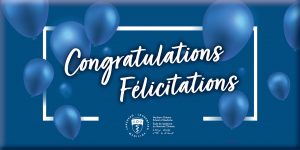As you have likely heard by now, on April 15, 2021, the Government of Ontario introduced legislation to establish the Northern Ontario School of Medicine as an independent, standalone degree-granting institution. I have received many questions since this happened asking about NOSM’s future. In light of Laurentian University’s Companies’ Creditor Arrangement Act (CCAA) proceedings, I am not allowed to comment further at this time. And as many of you know, we are still trying to navigate the loss of our revenue ($1.6 million) and to try to protect our endowments ($14 million) as a result of that situation. As well the accreditation bodies are now concerned about our financial situation. What I can’t say is what the implications are until the government’s bill is proclaimed in force.
What I can say to you is that nothing is changing. There have been several misleading statements made in the media and directly to NOSM partners that have instilled fear and panic with NOSM stakeholders. The fact is that NOSM is not leaving Thunder Bay or Sudbury. NOSM has wonderful, historical and strong affiliations with Laurentian and Lakehead Universities and we will build on them. We will continue to strengthen relationships with those cities and across a pan-northern community-based environment. NOSM is not taking any steps to change campuses, curricula, processes, policies or existing partnerships. We will continue to build on our relationships and work through our strategic plan The NOSM Challenge 2025 on transforming health human resource planning, advancing social accountability, innovating health professions education and strengthening research capacity in Northern Ontario. NOSM will continue to work with the rural, Indigenous and Francophone communities, learners, faculty, staff, and our institutional partners to remain an internationally renowned institution that prepares world-class health-care professionals to practise in Northern Ontario. And as always, you—our students, residents, staff and faculty come first.
NOSM was established as a government strategy to address the health needs of the region, improve access to quality care, and contribute to the economic development of Northern Ontario. The School is a stand-alone legal entity (not-for-profit corporation), governed by its own Board of Directors, with a unique funding model that differs from every other university and medical school in Canada. NOSM receives funding directly from the Ministry of Colleges and Universities and the Ministry of Health. However, under the current structure, NOSM does not have degree-granting status. The government’s intention is to grant NOSM that authority. The legislation has to go through three readings and then has to be proclaimed in force. There is a public consultation underway. You can contribute to that process here.
Please contact communications@nosm.ca with any additional questions that you may have.
NOSM has graduated 714 MDs, 48 self-identify as Indigenous, 151 self-identify as Francophone. In addition, 579 residents have completed NOSM programs. More than half of these health-practitioners have stayed in Northern Ontario, with the majority establishing their practice in Sudbury and Thunder Bay. The strategy is working but we have much more work to do. We have to help meet the current shortage of over 300 physicians across the North—and lead impactful population-based research.
Our mission to improve the health of Northern Ontarians by being socially accountable in our education and research programs and advocating for health equity, remains our focus.
We have demonstrated this recently.
- In support of Operation Remote Immunity, NOSM organized 22 teams consisting of learners, clinical faculty and staff to join Ornge, Nishnawbe Aski Nation, and many other partners in the roll out of COVID-19 vaccines to fly-in First Nations communities.
NOSM will keep leading in fighting this pandemic. - On March 23, 2021, NOSM signed a relationship accord with Nishnawbe Aski Nation (NAN) supporting the NAN Health Transformation process with the goal of developing mutually supported initiatives that will build capacity and strengthen the health system within NAN territory. We know that structural social inequities such as colonization, racism, social exclusion and repression of self-determination are important social determinants of health. We are committed to promoting innovation, discovery, and academic and clinical excellence within our School while building a culture of diversity, inclusion, integrity and empowerment. NOSM’s commitment to this will not change.
- NOSM faculty turned on a dime to innovate the curriculum during the pandemic and challenged students to advocate for impactful change in Northern Ontario. This learning experience resulted in innovations such as Project Connect and Naloxone North. NOSM faculty and learners are committed to social accountability—this is clear and demonstrated in all that they do. This will not change.
- Students led, organized and developed the Dean’s Lecture Series on Racism in Medicine. Over 100 people from the NOSM community participated in the very personal and heartfelt conversation with emotional testimonial and truth-telling by physician leaders across Canada. Panelists included Dr. Alika Lafontaine, Dr. Doris Mitchell, Dr. Gigi Osler, Dr. Amy Tan, and Dr. Kona Williams. Our plans to fight racism will not change.
- NOSM has named 2021 a year dedicated to climate and social justice. The NOSM Climate Change and Health Task Force recommends that the School views all parts of its new strategic plan through a climate change lens. More than 460 jurisdictions in Canada have declared climate emergencies, including Sudbury, Thunder Bay, Sioux Lookout, Kenora, and the leaders of Grand Council Treaty 3. NOSM is committed to critical action on climate change.
These are only a few examples of the transformative work being done at NOSM just since the beginning of 2021. What we’ve managed to accomplish in the last year—during a pandemic, no less—is nothing short of incredible.
For the first time in the School’s history, we have an official position on climate change and it’s prioritized in our strategic plan. The pandemic only further revealed the prevalent and worsening health issues caused by climate change across Northern Ontario.
As community members, we, too, witness immediate climate change threats to health. We see the worsening environmental impacts—whether they be extremely volatile conditions caused by unsafe water; critical food insecurity; insufficient and unsafe housing; extreme changes in weather conditions including the early deterioration of ice roads, extreme flooding and wildfire; or the significant migration or threats to traditional hunting and fishing. These issues affect us all.
Thank you to all members of the NOSM Task Force on Climate Change, which recently concluded its mandate and wrapped up. From the recommendations of the Task Force, I am launching a new committee called the NOSM Advisory Council on Climate Change (NACCC). This newly formed advisory council will deliver strategic coordinated, comprehensive climate action, starting by addressing climate change in our curriculum, policies and infrastructure. Today, I’m honoured to share NOSM’s position on climate change.

NOSM’s Commitment to Addressing Climate Change
Whereas the Northern Ontario School of Medicine acknowledges that climate change is a major health-care and public-health crisis and that all health-care professionals, whether in training or in practice for many years, have to be able to assess for, manage, and effectively treat the health effects of climate change.
And, whereas the impacts of climate change on health have become more prominent, a growing number of medical schools are adding climate-related content to the education and research programs.
We at NOSM commit to:
- Developing educational content, resources, and information on a wide variety of climate and health topics to inform and change our curriculum across all our education programs.
- Decarbonization in our activities and administration.
- Enabling healthier lifestyles to reduce carbon emissions.
- Investing in evidence-based research and improved surveillance of the health impacts of climate change.
Key resources:
- Planetary Health Report Card, 2019-2020
- The Climate Crisis is a Health Crisis
- The 2019 Report of The Lancet Countdown on Health and Climate Change: Ensuring that the Health of a Child Born Today is Not Defined by a Changing Climate

The time to act is now. April 22 is Earth Day, and I urge you to become a changemaker and advocate of NOSM’s climate change strategy. Connect with grassroots, local, regional and national efforts to address climate change. Please take the time to understand the emerging climate change threats to population health in Northern Ontario. Engage with climate change leaders in Northern Ontario.



